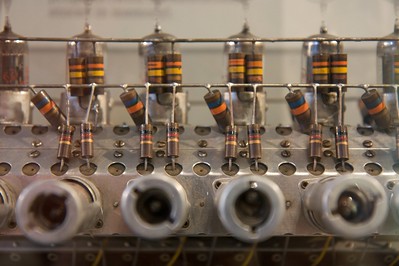Summary | Excerpt | Reviews | Beyond the Book | Read-Alikes | Genres & Themes | Author Bio

This article relates to The MANIAC
 The title of Benjamin Labatut's novel The MANIAC refers to the computer—the fastest of its kind at the time—developed by the Hungarian American physicist John von Neumann. During the Second World War, von Neumann was a consultant on the Manhattan Project at Los Alamos, New Mexico, where he focused on the detailed mathematical calculations needed to design the atomic bomb.
The title of Benjamin Labatut's novel The MANIAC refers to the computer—the fastest of its kind at the time—developed by the Hungarian American physicist John von Neumann. During the Second World War, von Neumann was a consultant on the Manhattan Project at Los Alamos, New Mexico, where he focused on the detailed mathematical calculations needed to design the atomic bomb.
According to the Los Alamos National Laboratory, when the site was first opened in 1943 as a secret lab for creating atomic weapons, most of the calculations were done manually by women, often with degrees in the sciences or mathematics: "The human computers and a collection of IBM punched-card machines conducted the numerical simulations that made it possible to field two unique weapon designs in only 27 months."
After the war ended, von Neumann continued to be involved in the development of nuclear weapons. He was a member of the Atomic Energy Commission and an advocate for the hydrogen bomb. The H-bomb project required a greater level of calculating power that became too time-consuming to be done by hand. The search for options led von Neumann to the US Army's Ballistics Research Laboratory, where one of the earliest digital computers, a calculating machine called the ENIAC, had been developed. According to Physics World, "Von Neumann collaborated with the designers of the ENIAC to produce a more effective design, which we now know as the stored-program computer—the blueprint for the post-war computer revolution."
Von Neumann built his computer at the Princeton Institute for Advanced Study. Next, the design was taken to Los Alamos, where physicist Nicholas Metropolis built a new version of the machine, which he called MANIAC I. Metropolis chose this name, an acronym for "Mathematical Analyzer, Numerical Integrator, and Computer." Von Neumann was resistant to the name, finding it "frivolous." Astrophysicist George Gamow joked that it stood for "Metropolis and Neumann Invent Awful Contraption."
The MANIAC came online in 1952 and was used for nuclear weapons calculations. The Los Alamos lab reports that the computer was "7-feet tall and 9-feet wide, with about 3,000 vacuum tubes. It weighed around 1,000 pounds." According to the lab, the machine could manage 10,000 operations per second, and was at the time the most powerful computer in the world. It was able to take on problems that had previously been impossible for scientists to solve.
The MANIAC was also distinctive because it was the first computer to beat a human opponent at chess. Eventually, companies like IBM began creating new computers that replaced early systems like the MANIAC. In 1958, the MANIAC was donated to the University of New Mexico.
Tubes and circuits used in MANIAC
Photo by Marcin Wichary (CC BY 2.0)
Filed under Medicine, Science and Tech
![]() This "beyond the book article" relates to The MANIAC. It originally ran in October 2023 and has been updated for the
October 2024 paperback edition.
Go to magazine.
This "beyond the book article" relates to The MANIAC. It originally ran in October 2023 and has been updated for the
October 2024 paperback edition.
Go to magazine.
Your guide toexceptional books
BookBrowse seeks out and recommends the best in contemporary fiction and nonfiction—books that not only engage and entertain but also deepen our understanding of ourselves and the world around us.